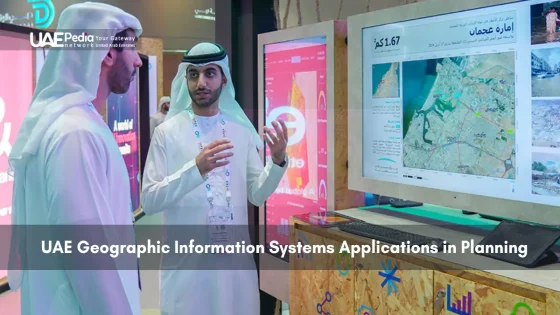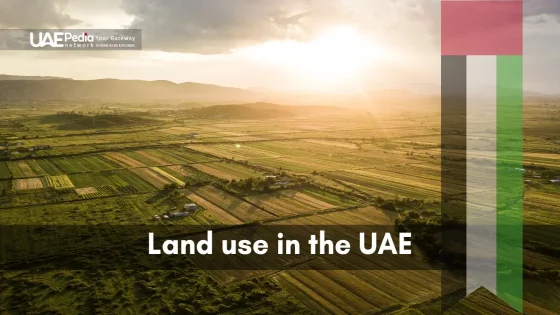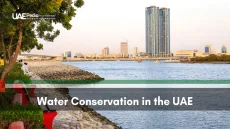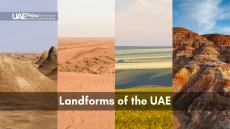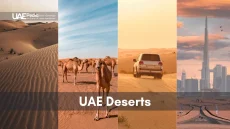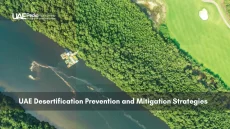What if New York City multiplied its footprint 54 times in 45 years? That’s exactly what Dubai did—exploding from 18 square kilometers in 1975 to over 977 by 2020. This jaw-dropping shift from windswept dunes to glass-and-steel marvels reveals a story far richer than skyscrapers and luxury resorts.
We’re walking through a paradox here. The same sands that once shaped Bedouin traditions now cradle hypermodern hubs—a tension between progress and preservation. Coastal mangroves whisper alongside highway networks, while mountain landforms watch over artificial islands. It’s not just about concrete replacing camel trails; it’s ecosystems adapting (or not) to humanity’s boldest urban experiments.
Consider this: 43 protected nature reserves now guard 14% of the nation’s territory. Yet even these sanctuaries feel the heat of nearby construction booms. The Emirates’ story isn’t black-and-white—it’s the shimmering gray area where ambition meets ancient ecosystems.
Key threads we’ll unravel:
- — How dune patterns influence skyscraper placement
- — Why 1975-2020 wasn’t just growth, but total landscape reinvention
- — The quiet comeback of native species in urban green spaces
Historical Context of Urbanization in the UAE
Imagine sipping karak chai where your ancestors once tracked star patterns for survival. That’s the story of the united arab’s transformation—a journey from pearl-diving villages to cities that redefined what’s possible. Before skylines pierced the clouds, communities thrived around oases and trade routes, their rhythms synced to desert seasons.
From Desert Towns to Modern Metropolises
In the 1930s, mud-brick homes clustered near falaj water channels. Fast-forward a century, and those same spots host metro stations buzzing with global commuters. Take Abu Dhabi’s Corniche—once a fishing harbor, now a palm-lined promenade framing futuristic towers. This shift wasn’t accidental. Visionary leadership turned oil wealth into highways, ports, and airports, stitching seven emirates into a cohesive powerhouse.
Key Development Milestones Over the Past Century
Let’s break it down:
- 1958: First oil exports—cash flow that funded schools, hospitals, and desalination plants
- 1971: Federation formed, uniting ambitions under one flag
- 1985: Emirates Airline launched, connecting desert hubs to global networks
- 2010: Burj Khalifa’s debut—a vertical statement of progress
Behind these headlines? Strategic master plans prioritizing diversification. As one planner noted: “We built cities not just for oil, but for ideas.” From free trade zones to Louvre Abu Dhabi, every project whispers this ethos.
UAE Urbanization impact: Evolution and Driving Forces
Picture Silicon Valley’s tech boom—but swap microchips for megaprojects. That’s the story behind the Emirates’ skyline revolution. Oil revenues didn’t just fund towers; they built entire ecosystems where sand once ruled. A 2023 study reveals how every $1 billion in oil exports triggered $3.8 billion in infrastructure bets between 1975-2020.
The Blueprint Beneath the Boom
Planners here play 4D chess. Take Dubai’s Palm Jumeirah: 11 million truckloads of rock transformed into a luxury archipelago. “We don’t follow maps—we redraw them,” quips a veteran engineer. This ethos birthed world-class ports, solar farms, and metro systems connecting dunes to designer malls.
Skyline as Sales Pitch
Burj Khalifa isn’t just tall—it’s a economic manifesto in glass. Since its 2010 debut, tourism tripled, pulling in $30 billion annually. But the real magic? How souqs evolved into startup hubs. Walk Dubai’s DIFC district today: fintech coders brainstorm where pearl divers once haggled.
“Our cities are CVs written in concrete.”
From wind towers to smart cities, every leap balances tradition with tomorrow. The result? A laboratory where Bedouin wisdom meets AI-powered traffic systems—and 9 million residents vote with their feet.
Environmental Adaptability and Ecosystem Challenges
Imagine desert roots cracking through concrete sidewalks—nature’s quiet rebellion against paved progress. Our cities now face a critical test: can engineered systems keep pace with ecosystems shaped over millennia?
When Concrete Meets Cryptic Waterways
Flash floods in 2023 revealed hidden tensions. Storm drains built for 1990s rainfall patterns overflowed as climate change delivered 3 years’ rain in 6 hours. “We’re racing against evolutionary clocks,” notes a Sharjah hydrologist. Natural wadis once absorbed 80% of rainwater; today’s asphalt redirects it into parking garages.
| Natural vs Urban Water Absorption | Native Soil | Urban Surfaces |
|---|---|---|
| Rainwater absorption rate | 75-90% | 15-25% |
| Native plant survival rate | 95% | 34% |
| Flood recurrence interval | 50 years | 2-5 years |
Salt-tolerant shrubs like Arthrocnemum macrostachyum now battle irrigation runoff. Their survival trick? Filtering 90% of salt through roots—a feat our pipes can’t replicate. Yet green corridors in Al Ain prove resilient species adapt when given breathing room.
Climate change plays wildcard. Unpredictable storms stress both aging infrastructure and delicate dune ecosystems. The solution? Hybrid designs blending ancient wisdom—like falaj water channels—with permeable smart concrete.
So where’s the balance? Maybe it’s not choosing between growth and preservation, but reimagining how they coexist. What if cities could evolve like desert flora—rooted yet flexible, thriving through collaboration with the land?
Rapid Urban Growth and Infrastructure Vulnerabilities
When skyscrapers meet sandstorms, who blinks first? The answer lies beneath our feet. Cities built at hyperspeed face a hidden truth: engineered systems often struggle against forces that shaped deserts for millennia. You’ve seen the viral videos—roads becoming rivers after sudden rains, luxury districts knee-deep in runoff. These aren’t freak events but wake-up calls.
Modern Engineering vs. Organic Urban Resilience
Glass towers rely on pumps and pipes, while ancient settlements used wadis as natural storm channels. A recent study found 78% of 2023 flood damage occurred in areas with impermeable surfaces. Compare that to historic districts using porous coral stone, which absorb 40% more rainwater. The lesson? Sometimes slower is stronger.
| Resilience Factor | Modern Infrastructure | Historic Systems |
|---|---|---|
| Water Absorption Rate | 22% | 63% |
| Flood Recovery Time | 5-7 days | 12-24 hours |
| Material Longevity | 25-50 years | 100+ years |
Lessons from Recent Flash Floods and Drainage Issues
Last April’s storms overwhelmed drainage designed for 1990s rainfall patterns. Construction zones added pressure—every new parking lot reduced the land’s natural sponge effect. “We’re building roofs faster than gutters,” admits a Dubai civil engineer. Solutions? Think permeable pavements in Business Bay and rooftop gardens in Jumeirah.
Resilience isn’t about stopping nature but flowing with it. Next-gen projects now mimic desert roots, using smart sensors to redirect water. The goal? Cities that adapt like the Prosopis cineraria tree—thriving in droughts yet ready for downpours.
Climate Change Intersections with Urban Development
What happens when 50°C days become the new normal? Cities built for endless sunshine now face erratic storms and rising seas—a reality demanding radical reinvention. Last year’s record-breaking floods submerged highways, while heatwaves pushed power grids to their limits. These aren’t isolated incidents but urgent signals for smarter strategies.
Extreme Weather Events and Their Implications
Flash floods once rare now strike like clockwork. In 2023, rainfall surpassed annual averages in six hours—overwhelming drains designed for gentler eras. “We’re building chessboards while nature plays poker,” quips a Sharjah infrastructure planner. The stakes? Urban systems that keep pace with climate shifts while protecting communities.
| Traditional vs Adaptive Approaches | Absorption Rate | Temperature Reduction | Cost Efficiency |
|---|---|---|---|
| Concrete surfaces | 18% | 0.5°C | $1.2M/km |
| Permeable pavement | 67% | 2.3°C | $1.8M/km |
| Green roofs | 82% | 4.1°C | $2.4M/km |
Forward-thinking processes are emerging. Dubai’s new districts use “sponge city” principles—parks double as flood basins during storms. Abu Dhabi’s smart grids redirect energy when demand spikes during heatwaves. Even historic sustainability tricks resurface: wind towers now integrate with AC systems to cut energy use by 40%.
The key lies in blending innovation with humility. As one engineer notes:
“Our cities must evolve like the desert—adapting swiftly but staying rooted.”
Tomorrow’s blueprints? Think solar-powered bus stops that cool sidewalks. Rooftop farms that slash food miles. Every choice today writes the next chapter in this race against rising thermometers—and rising tides.
Real Estate Transformation and Sustainable Urban Planning
What if golden faucets could water native shrubs? That’s the puzzle facing developers here, where luxury towers rise beside protected mangroves. The past decade saw over $76 billion invested in high-profile projects—each vying to outdo the last in grandeur and green credentials.
Glass Towers Meet Green Ambitions
Take Palm Jumeirah’s latest phase: solar-powered villas with rooftop native gardens. “We’re not just selling views—we’re curating ecosystems,” says a Dubai-based developer. These estates use 40% less water than conventional builds, thanks to smart irrigation tapping into treated wastewater.
| Feature | Traditional Approach | Sustainable Solution |
|---|---|---|
| Energy Source | Grid electricity | Building-integrated solar |
| Water Use | Desalinated supply | Greywater recycling |
| Materials | Imported concrete | Local recycled aggregates |
| Cooling Systems | Central AC | Wind tower hybrids |
Burj Khalifa’s recent retrofit shows this balance. Its new cladding reflects 30% more sunlight, cutting cooling costs by $400,000 annually. Meanwhile, underground thermal labyrinths—inspired by ancient Persian yakhchāls—keep lobby temperatures comfortable without overloading grids.
“Luxury isn’t about excess anymore—it’s about intelligent design.”
For investors eyeing this market: prioritize LEED-certified contractors. Seek projects preserving existing wadis or dunes. And remember—today’s buyers value carbon-neutral gyms as much as gold-plated fixtures. The future? Developments that feel like natural extensions of the landscape, not impositions upon it.
Social Inequalities and Community Access in a Growing City
Picture this: a luxury condo’s infinity pool reflects moonlight while, three blocks away, twelve workers share a single windowless room. This jarring contrast defines life in many fast-growing cities—where gleaming towers cast long shadows over hidden struggles.
Rapid growth creates parallel worlds. In Dubai Silicon Oasis, tech families enjoy walkable schools and 24/7 clinics. Meanwhile, Al Quoz labor camps house delivery drivers facing hour-long commutes to basic services. These gaps aren’t accidents—they’re baked into urban blueprints prioritizing capital over community.
Disparities in Housing, Education, and Healthcare
Let’s crunch numbers. High-income expats occupy 78% of premium housing but make up just 12% of the population. Migrant workers—41% of residents—often live in districts with 1 clinic per 15,000 people. Schools tell a similar story: international academies outnumber affordable options 3-to-1 in growth areas.
| Service Access Comparison | Affluent Zones | Labor Communities |
|---|---|---|
| Average commute to hospital | 8 minutes | 47 minutes |
| Students per classroom | 18 | 34 |
| Green space per capita | 27m² | 3.2m² |
Overcrowding sparks health crises. A 2023 paper found respiratory issues 60% higher in worker housing. “We build cities for shareholders first, people second,” admits a policy analyst. The fix? Redirecting capital to projects benefiting all income tiers.
Community Engagement and Inclusive Urban Policy
Change brews in unexpected places. Ras Al Khaimah’s new participatory budgeting program lets residents vote on park upgrades and bus routes. One participant shared: “Finally, our voices count beyond paycheck deductions.”
Smart policies are emerging:
- — Affordable housing quotas in new developments
- — Mobile health units reaching industrial zones
- — Night schools for workers pursuing certifications
True progress needs more than spreadsheets. As a community organizer notes:
“Equality isn’t about equal height—it’s about removing ceilings.”
The road ahead? Cities where opportunity isn’t a lottery—but a shared design.
Moving Forward: Resilient and Inclusive Urban Futures
Imagine cities that breathe like living organisms—pulsing with tech yet rooted in ancient sands. The journey from pearl-diving villages to global hubs reveals a clear truth: thriving cities need both steel and soul. Lessons from flash floods to green corridors show our best plans mimic nature’s flexibility.
Future systems must act like desert acacias—strong enough to withstand storms, supple enough to bend without breaking. Think permeable pavements cooling sidewalks, wind towers cutting AC loads, and neighborhoods where schools and clinics sit a walk away from all incomes. It’s about weaving resilience into every layer, from storm drains to social policies.
Three shifts can guide this transformation:
- — Design with dual purpose: parks that store floodwater, buildings that generate energy
- — Plan with communities, not just for them—participatory budgets and housing quotas
- — Let landforms lead: align skylines with dune patterns, let wadis guide drainage
The road ahead isn’t about stopping growth—it’s about growing smarter. Cities that honor their past while innovating for tomorrow don’t just survive; they become blueprints for the world. Ready to help write the next chapter? Let’s build futures where every voice shapes the skyline.
Coastal trading posts like Dubai and Abu Dhabi leveraged oil wealth and strategic location to build ports, airports, and tax-free zones. Projects like Burj Khalifa and Louvre Abu Dhabi shifted global perceptions, blending Bedouin heritage with futuristic ambition.
Urban sprawl disrupts desert ecosystems—think displaced gazelles and stressed date palms. Groundwater depletion and coastal development threaten mangroves, while heat-island effects amplify summer temperatures. Green zoning policies now prioritize native plant corridors and wadi preservation.
Developments like Masdar City and Al Barari prove yes—solar-powered villas meet recycled-material skyscrapers. Challenges remain in balancing tourism-driven projects (think Palm Jumeirah) with carbon-neutral targets. The UAE’s 2036 Agenda pushes LEED-certified buildings and smart water grids.
A> April 2024’s record rains overwhelmed drainage systems built for arid climates. Lessons emerged: Sharjah’s new flood tunnels, Abu Dhabi’s permeable pavement trials, and community sandbag networks. Future plans integrate AI weather modeling into urban designs.
A> Service workers often face long commutes from affordable suburbs to glittering downtowns. Initiatives like Dubai’s “Humanitarian City” aim to bridge gaps through subsidized housing and skills programs, though equitable healthcare access remains a work in progress.
A> Architects now design “thermal-break” buildings to combat 50°C summers. Coastal cities invest in coral reef buffers against rising seas, while desert towns like Al Ain revive ancient falaj irrigation for greener public spaces. It’s a lab for adaptive innovation.

